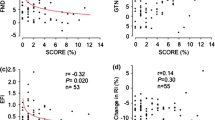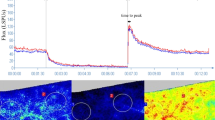Abstract
Microangiopathy should be noted in diabetes with subclinical vascular diseases. Little is known about whether various surrogate markers of systemic arterial trees exacerbate simultaneously in preclinical atherosclerosis. To clarify the association of skin microvascular reactivity with arterial stiffness is essential to elucidating early atherosclerotic changes. The post-occlusive reactive hyperemia of skin microcirculation was evaluated in 27 control and 65 type 2 diabetic subjects, including 31 microalbuminuria (MAU) and 34 normoalbuminuria (NAU) patients. The laser Doppler skin perfusion signals were transformed into three frequency intervals for the investigation of endothelial, neurogenic, and myogenic effects on basal and reactive flow motion changes. The analysis of spectral intensity and distribution provided insight into potential significance of microvascular regulation in subclinical atherosclerotic diseases. Systemic arterial stiffness was studied by the brachial ankle pulse wave velocity (baPWV). Following occlusive ischemia, the percent change of endothelial flow motion was lower in MAU than in NAU and control groups. The MAU group revealed a relative increase in myogenic activity and a decrease in endothelial activity in normalized spectra. The baPWV showed more significant associations with reactive endothelial change (r = − 0.48, P < 0.01) and normalized myogenic value (r = − 0.37, P < 0.05) than diabetes duration and HbA1c. By multivariate regression analysis, only endothelial vasomotor changes independently contributed to the decreased baPWV (OR 3.47, 95% CI 1.63–7.42, P < 0.05). Impaired microcirculatory control is associated with increased arterial stiffness in preclinical atherosclerosis. To identify the early manifestations is necessary for at-risk patients to prevent from further vascular damage.


Similar content being viewed by others
Abbreviations
- MAU:
-
Diabetes with microalbuminuria
- NAU:
-
Diabetes with normoalbuminuria
- baPWV:
-
Brachial ankle pulse wave velocity
References
Strain WD, Paldánius PM (2018) Diabetes, cardiovascular disease and the microcirculation. Cardiovasc Diabetol 17:57
Tomiyama H, Matsumoto C, Shiina K, Yamashina A (2016) Brachial-Ankle PWV: current status and future directions as a useful marker in the management of cardiovascular disease and/or cardiovascular risk factors. J Atheroscler Thromb 23:128–146
Sougawa Y, Miyai N, Utsumi M, Miyashita K, Takeda S, Arita M (2020) Brachial-ankle pulse wave velocity in healthy Japanese adolescents: reference values for the assessment of arterial stiffness and cardiovascular risk profiles. Hypertens Res 43:331–341
Sorelli M, Francia P, Bocchi L (2019) Assessment of cutaneous microcirculation by laser Doppler flowmetry in type 1 diabetes. Microvasc Res 124:91–96
Fuchs D, Dupon PP, Schaap LA, Draijer R (2017) The association between diabetes and dermal microvascular dysfunction non-invasively assessed by laser Doppler with local thermal hyperemia: a systematic review with meta-analysis. Cardiovasc Diabetol 16:11
Hu HF, Hsiu H, Sung CJ, Lee CH (2017) Combining laser-Doppler flowmetry measurements with spectral analysis to study different microcirculatory effects in human prediabetic and diabetic subjects. Lasers Med Sci 32:327–334
Sun PC, Chen CS, Kuo CD, Lin HD, Chan RC, Wei SH (2012) Impaired microvascular flow motion in subclinical diabetic feet with sudomotor dysfunction. Microvasc Res 83:243–248
Abdelhafiz AH, Ahmed S, El Nahas M (2011) Microalbuminuria: marker or maker of cardiovascular disease. Nephron Exp Nephrol 119:e6-10
Chang LH, Lin HD, Kwok CF et al (2014) The combination of the ankle brachial index and brachial ankle pulse wave velocity exhibits a superior association with outcomes in diabetic patients. Intern Med 53:2425–2431
Kvandal P, Stefanovska A, Veber M, Kvermmo HD, Kirkeboen KA (2003) Regulation of human cutaneous circulation evaluated by laser Doppler flowmetry, iontophoresis, and spectral analysis: importance of nitric oxide and prostaglandins. Microvasc Res 61:160–171
Rossi M, Cupisti A, Di Maria C, Galetta F, Santoro G (2008) Blunted post-ischemic increase of the endothelial skin blood flow motion component as early sign of endothelial dysfunction in chronic kidney disease patients. Microvasc Res 75:315–322
Hayden MR, Sowers JR, Tyagi SC (2005) The central role of vascular extracellular matrix and basement membrane remodeling in metabolic syndrome and type 2 diabetes: the matrix preloaded. Cardiovasc Diabetol 4:9
Zhang Y, Lacolley P, Protogerou AD, Safar ME (2020) Arterial Stiffness in Hypertension and Function of Large Arteries. Am J Hypertens 33:291–296
Sawada S, Tsuchiya S, Kodama S, Kurosawa S, Endo A, Sugawara H (2020) Vascular resistance of carotid and vertebral arteries is associated with retinal microcirculation measured by laser speckle flowgraphy in patients with type 2 diabetes mellitus. Diabetes Res Clin Pract 165:108–240
Safar ME, Struijker-Boudier HA (2010) Cross-talk between macro- and microcirculation. Acta Physiol (Oxf) 198:417–430
Jonasson H, Bergstrand S, Nystrom FH, Länne T, Östgren CJ, Bjarnegård N (2017) Skin microvascular endothelial dysfunction is associated with type 2 diabetes independently of microalbuminuria and arterial stiffness. Diab Vasc Dis Res 14:363–371
Zandbergen AA, Sijbrands EJ, Lamberts SW, Bootsma AH (2006) Normotensive women with type 2 diabetes and microalbuminuria are at high risk for macrovascular disease. Diabetes Care 29:1851–1855
Roustit M, Cracowski JL (2012) Non-invasive assessment of skin microvascular function in humans: an insight into methods. Microcirculation 19:47–64
Cupisti A, Rossi M, Placidi S, Caprioli R, Morelli E, Vagheggini G (2000) Response of the skin microcirculation to acetylcholine and sodium nitroprusside in chronic uremic patients. Int J Clin Lab Res 30:157–162
Babos L, Járai Z, Nemcsik J (2013) Evaluation of microvascular reactivity with laser Doppler flowmetry in chronic kidney disease. World J Nephrol 2:77–83
Schmiedel O, Schroeter ML, Harvey JN (2007) Microalbuminuria in type 2 diabetes indicates impaired microvascular vasomotion and perfusion. Am J Physiol Heart Circ Physiol 293:H3424–H3431
Houben AJHM, Martens RJH, Stehouwer CDA (2017) Assessing microvascular function in humans from a chronic disease perspective. J Am Soc Nephrol 28:3461–3472
Farkas K, Nemcsik J, Kolossváry E, Járai Z, Nádory E, Farsang C (2005) Impairment of skin microvascular reactivity in hypertension and uraemia. Nephrol Dial Transplant 20:1821–1827
Smogorzewski M (2017) Skin blood flow and vascular endothelium function in uremia. J Ren Nutr 27:465–469
Lacolley P, Regnault V, Segers P, Laurent S (2017) Vascular smooth muscle cells and arterial stiffening: relevance in development, aging, and disease. Physiol Rev 97:1555–1617
Lacolley P, Regnault V, Avolio AP (2018) Smooth muscle cell and arterial aging: basic and clinical aspects. Cardiovasc Res 114:513–528
Vinik AI, Erbas T, Park TS, Stansberry KB, Scanelli JA, Pittenger GL (2001) Dermal neurovascular dysfunction in type 2 diabetes. Diabetes Care 24:1468–1475
Lespagnol E, Dauchet L, Pawlak-Chaouch M, Balestra C, Berthoin S, Feelisch M (2020) Early endothelial dysfunction in type 1 diabetes is accompanied by an impairment of vascular smooth muscle function: A Meta-Analysis. Front Endocrinol (Lausanne) 11:203
Durand S, Zhang R, Cui J, Wilson TE, Crandall CG (2004) Evidence of a myogenic response in vasomotor control of forearm and palm cutaneous microcirculations. J Appl Physiol 97:535–539
Tuna BG, Bakker EN, VanBavel E (2012) Smooth muscle biomechanics and plasticity: relevance for vascular calibre and remodelling. Basic Clin Pharmacol Toxicol 110:35–41
Leo F, Krenz T, Wolff G, Weidenbach M, Heiss C, Kelm M (2020) Assessment of tissue perfusion and vascular function in mice by scanning laser Doppler perfusion imaging. Biochem Pharmacol 176:1138–1193
Sun PC, Kuo CD, Chi LY, Lin HD, Wei SW, Chen CS (2013) Microcirculatory vasomotor changes are associated with severity of peripheral neuropathy in patients with type 2 diabetes. Diab Vasc Dis Res 10:270–276
Tao J, Jin YF, Yang Z, Wang LC, Gao XR, Lui L (2004) Reduced arterial elasticity is associated with endothelial dysfunction in persons of advancing age: comparative study of noninvasive pulse wave analysis and laser Doppler blood flow measurement. Am J Hypertens 17:654–659
Shamim-Uizzaman Q, Pfenninger D, Kehrer C (2002) Altered cutaneous microvascular responses to reactive hyperemia in coronary artery disease: a comparative study with conduit vessel responses. Clin Sci 103:267–273
Çekiç EG, Başaran Ö, Filiz Başaran N, Elmas O, Doğan V, Mert GÖ (2017) Cutaneous microvascular reactivity and aortic elasticity in coronary artery disease: Comparison of the laser Doppler flowmetry and echocardiography. Microvasc Res 109:19–25
Author information
Authors and Affiliations
Contributions
Study concept and design: Drs Sun, Wei. Recruitment of patients, acquisition of data: Drs Wei, Lin. Analysis and interpretation of data: Drs Sun, Kuo. Draft of the manuscript: Drs Sun, Kuo. Administrative, technical or material support: Drs Kuo, Lin.
Corresponding author
Ethics declarations
Informed consent
Yes.
Conflict of interest
The authors declare no competing interests.
Additional information
Publisher's note
Springer Nature remains neutral with regard to jurisdictional claims in published maps and institutional affiliations.
Rights and permissions
Springer Nature or its licensor (e.g. a society or other partner) holds exclusive rights to this article under a publishing agreement with the author(s) or other rightsholder(s); author self-archiving of the accepted manuscript version of this article is solely governed by the terms of such publishing agreement and applicable law.
About this article
Cite this article
Sun, PC., Kuo, CD., Wei, SH. et al. Microvascular reactivity using laser Doppler measurement in type 2 diabetes with subclinical atherosclerosis. Lasers Med Sci 38, 80 (2023). https://doi.org/10.1007/s10103-023-03737-x
Received:
Accepted:
Published:
DOI: https://doi.org/10.1007/s10103-023-03737-x




